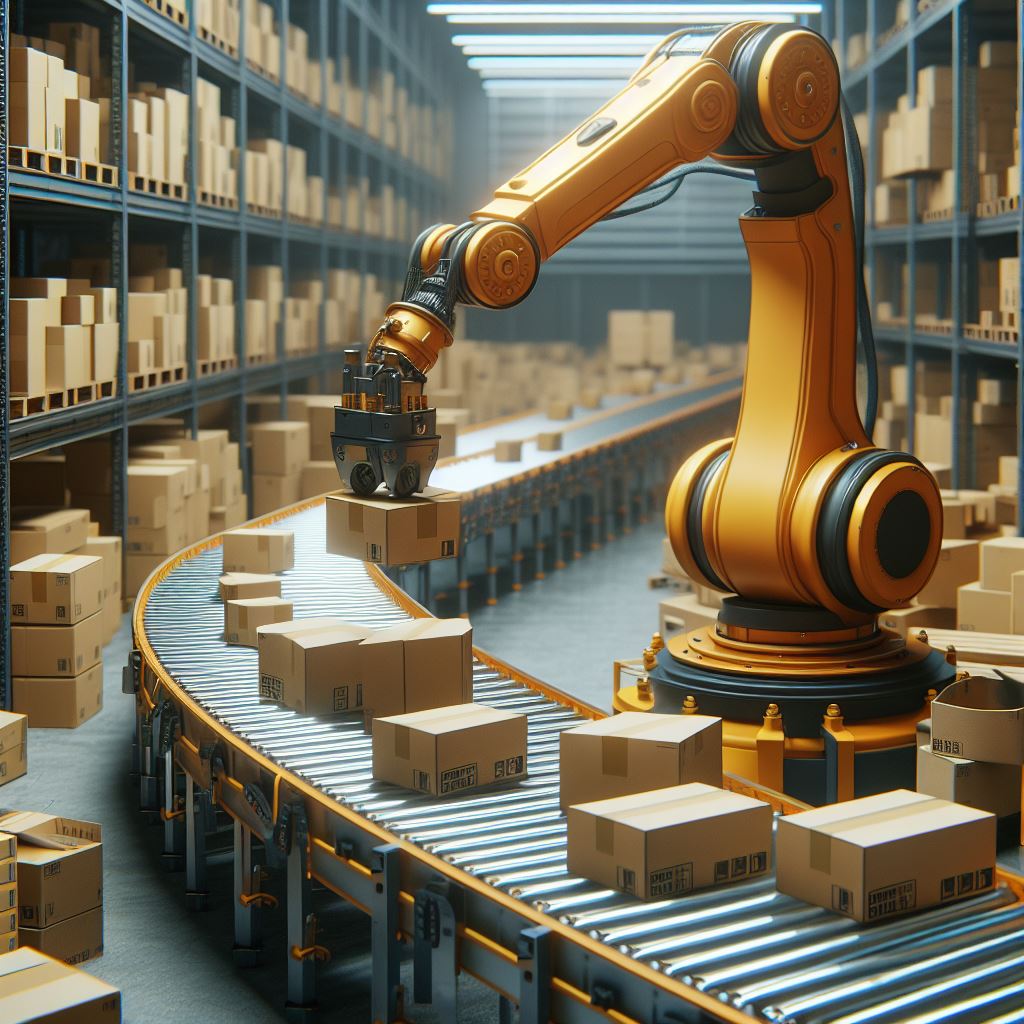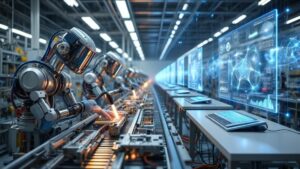AI for Warehouse Automation and Inventory Management
Imagine this: by 2027, more than a quarter (26%) of warehouses will have embraced automation, a significant jump from the 14% recorded just ten years ago. What’s fueling this surge? Well, it’s a mix of factors, including the growing impact of e-commerce and the challenges brought on by the Covid-19 pandemic.
At the forefront of this automation wave is AI, playing a pivotal role in transforming warehouses. But why AI? With its ability to process data rapidly and adapt to changing circumstances, AI is becoming the driving force behind the efficiency and accuracy we expect in modern warehouse management.
In this blog, we’re going to unravel the why and how of AI in warehouse automation and inventory management. Join us as we explore the exciting ways AI is shaping the future of logistics and revolutionizing the way we handle inventory.
The Dominant Role of AI in Warehouse Transformation
AI has become the linchpin of warehouse transformation, revolutionizing the way businesses manage their operations. Its multifaceted capabilities are not just reshaping processes; they are fundamentally altering the landscape of warehouse management. Here’s a closer look at the pivotal role AI plays and the diverse ways it is influencing warehouse operations for businesses:
Related Read: AI in Warehouse Management
Enhancing Efficiency through Precision
AI takes the reins in boosting efficiency within warehouses, acting as a digital powerhouse that fine-tunes processes for optimal performance.
Firstly, AI acts as a meticulous process optimizer. Think of it as a super-smart detective analyzing heaps of data to identify where things could be done more efficiently in the warehouse. By pinpointing these areas, AI helps businesses streamline their operations, making tasks smoother and reducing unnecessary delays.
Secondly, AI steps into the realm of predictive analytics. It becomes a strategic planner, using advanced algorithms to foresee what products will be in demand. This isn’t just guesswork; it’s a calculated forecast. With this insight, warehouses can plan ahead, ensuring they have the right items in stock when customers need them. This proactive approach minimizes delays and ensures a seamless response to customer demands.
Precision in Inventory Management
Maintaining a precise inventory is the heartbeat of a well-functioning warehouse, and Artificial Intelligence (AI) emerges as the meticulous caretaker in this critical aspect.
Powered by advanced algorithms, AI-driven systems become vigilant guardians against errors, minimizing discrepancies that might arise in manual tracking. This precision translates into a more reliable and trustworthy inventory system, reducing the chances of mistakes that could lead to delays or confusion within the warehouse.
AI’s analytical prowess extends to forecasting future demand with remarkable accuracy. By analyzing historical data and utilizing predictive analytics, AI becomes a strategic ally in preventing overstock or stockouts. According to McKinsey Digital, businesses leveraging AI-powered forecasting witness a significant reduction in errors by 30 to 50% within their supply chain networks. This improved accuracy translates into tangible benefits, such as a remarkable 65% reduction in lost sales due to inventory out-of-stock situations and a noteworthy decrease in warehousing costs ranging from 10 to 40%.
Improving Customer Experience
Efficient inventory management and warehouse automation serve as cornerstones in elevating customer satisfaction, providing a seamless and gratifying experience.
1. Swift Order Fulfillment
Imagine a scenario where inventory is meticulously managed, thanks to AI’s precision. Orders are processed with speed and accuracy, ensuring that customers receive their desired products promptly. With automation seamlessly handling tasks like picking, packing, and shipping, the entire order fulfillment process becomes a well-orchestrated symphony, delighting customers with swift and reliable service.
2. Accurate Order Processing
The marriage of good inventory management and warehouse automation ensures that the right products are always in stock. AI’s predictive analytics anticipate customer demands, reducing the likelihood of stockouts or overstock situations. Automated systems further contribute by minimizing errors in order processing. Customers receive precisely what they ordered, fostering trust and confidence in the brand’s reliability.
3. Enhanced Product Availability
Customers appreciate finding their desired items consistently available. Effective inventory management, guided by AI insights, ensures that popular products are adequately stocked. Warehouse automation aids in maintaining optimal stock levels, reducing instances of products being unavailable. This consistency in product availability contributes significantly to a positive customer experience, as it aligns with their expectations and needs.
4. Personalized Service
AI’s ability to analyze customer data contributes to personalized service. When integrated with inventory management, it allows businesses to understand individual preferences and tailor recommendations. Automation facilitates the implementation of these personalized touches, from customized packaging to order-tracking notifications. Such attention to detail enhances the overall customer experience, making customers feel valued and understood.
Proactive Issue Resolution
AI watches over everything in real time, predicting possible issues before they happen. It’s like having a smart assistant that tells you when something might go wrong with the equipment. By fixing things before they break, AI helps warehouses avoid unexpected stops and keeps everything running smoothly.
AI also acts as a strategic planner for potential problems in the supply chain. Whether it’s issues with suppliers or delays in transportation, AI looks at past data and current situations to predict possible challenges. It’s like having a friend who helps you see potential issues on the road ahead. By addressing these challenges before they become big problems, AI ensures that warehouses can handle whatever comes their way without major disruptions.
Integration of the Internet of Things (IoT) for Real-Time Monitoring
AI joins forces with IoT devices equipped with sensors to keep a vigilant eye on warehouse conditions in real time. These smart sensors act like super-sleuths, monitoring factors like temperature, humidity, and other environmental variables. Together, AI and IoT ensure that storage conditions remain optimal, preventing inventory spoilage. It’s like having a team of watchful guardians that instantly alert when conditions veer away from the ideal, preserving the integrity of stored goods.
The partnership between AI and IoT extends to equipment maintenance. AI analyzes data collected from IoT-connected machinery to predict when maintenance is needed. This predictive maintenance approach is like having a crystal ball for equipment health. FactMR report suggests that by the year 2031, the market for IoT in warehouse management is expected to reach a substantial value of $15 billion.
How are Businesses Automating Warehouses Using AI
Businesses are increasingly turning to artificial intelligence (AI) to automate their warehouses and streamline inventory management. This tech infusion is leading to faster fulfillment times, reduced costs, and a more efficient overall supply chain.
Autonomous Mobile Robots (AMRs)
How they work: AMRs use advanced technologies like LiDAR (Light Detection and Ranging) and cameras for navigation. They operate independently, carrying out tasks such as transporting goods, picking items from shelves, and collaborating with human workers.
Benefits: AMRs enhance efficiency by automating labor-intensive tasks. They are flexible and adaptable, easily reprogrammed to accommodate changes in warehouse layouts or operational needs. This leads to faster fulfillment times and a reduction in labor costs.
Computer Vision for Smarter Sorting
How it works: AI-powered vision systems, including cameras and sophisticated algorithms, collaborate to identify, sort, and track inventory in real time. Amazon’s Kiva robots, for instance, use computer vision to navigate warehouse shelves autonomously.
Benefits: By eliminating manual scanning and human error, computer vision enhances accuracy and speed in inventory management. This results in more efficient warehouse operations, reducing the likelihood of errors in order processing.
Voice-Activated Warehouse Systems
How they work: Workers use voice commands to interact with robots and control various warehouse processes. This hands-free approach allows for tasks like inventory checks and order status updates without relying on traditional paper-based systems.
Benefits: The adoption of voice-activated systems increases productivity by reducing the time spent on manual data entry. It also enhances worker mobility and flexibility, as employees can perform tasks while on the move.
Drones Take Flight for Faster Fulfillment
How they work: Drones navigate through warehouses, retrieving items and delivering them to designated packing stations. This aerial approach is particularly beneficial for speeding up the fulfillment of large or bulky items.
Benefits: Drones enhance efficiency in picking and transporting goods within the warehouse. They are especially valuable in scenarios where rapid fulfillment is crucial, providing a quicker alternative to traditional manual methods.
Internet of Things (IoT) Sensors
How they work: Tiny IoT sensors are deployed throughout the warehouse, tracking various parameters such as temperature, humidity, equipment health, and worker locations. The data collected by these sensors feeds into AI systems.
Benefits: IoT sensors provide real-time insights into warehouse conditions, allowing businesses to optimize operations. For instance, tracking temperature ensures the preservation of sensitive goods, while monitoring equipment health allows for predictive maintenance, reducing downtime.
Beyond 2023: The Future of AI-Powered Warehouses
As we look ahead, the future of warehouse automation holds exciting prospects, with advancements that promise to reshape the landscape:
Collaborative Robotics
The rise of cobots, collaborative robots designed to work alongside human counterparts, will redefine the dynamics of warehouse labor. These intelligent machines are not intended to replace humans but rather to collaborate seamlessly, enhancing efficiency and productivity. Cobots will contribute to a more harmonious and efficient workflow, where human and machine labor complement each other.
Embedded Processing Power
The evolution of Edge AI involves embedding processing power directly into warehouse devices. This shift enables faster decision-making at the source of data generation, facilitating real-time optimization. By minimizing the need for data to travel to central processing units, Edge AI enhances responsiveness, making warehouse operations even more agile and efficient.
Virtual Warehouse Replicas
The advent of digital twins introduces virtual replicas of physical warehouses. These digital counterparts serve as testing grounds for optimizing processes before implementation in the physical space. Businesses can simulate and fine-tune various scenarios, ensuring that operational strategies are thoroughly vetted and refined in the virtual realm before being executed in the real-world setting.
Wrapping Up
AI is not an abstract concept; it’s a pragmatic tool reshaping the warehouse landscape. It’s about tangible benefits – faster fulfillment, reduced errors, and a supply chain that adapts in real time.
Consider the numbers – by 2027, a solid 25% of warehouses are set to be automated. This isn’t an arbitrary statistic; it reflects a fundamental shift in how warehouses operate. Looking forward, things get even more interesting. Robots working alongside people, AI making quick decisions, and virtual replicas helping perfect the game plan before it hits the ground – that’s the future we’re looking at.
Revolutionize your warehouse operations with RTS Labs – Pioneers in AI Consulting for the Modern Warehouse. From smarter inventory management to streamlined processes and unprecedented efficiency, RTS Labs is ready to transform your operations!






